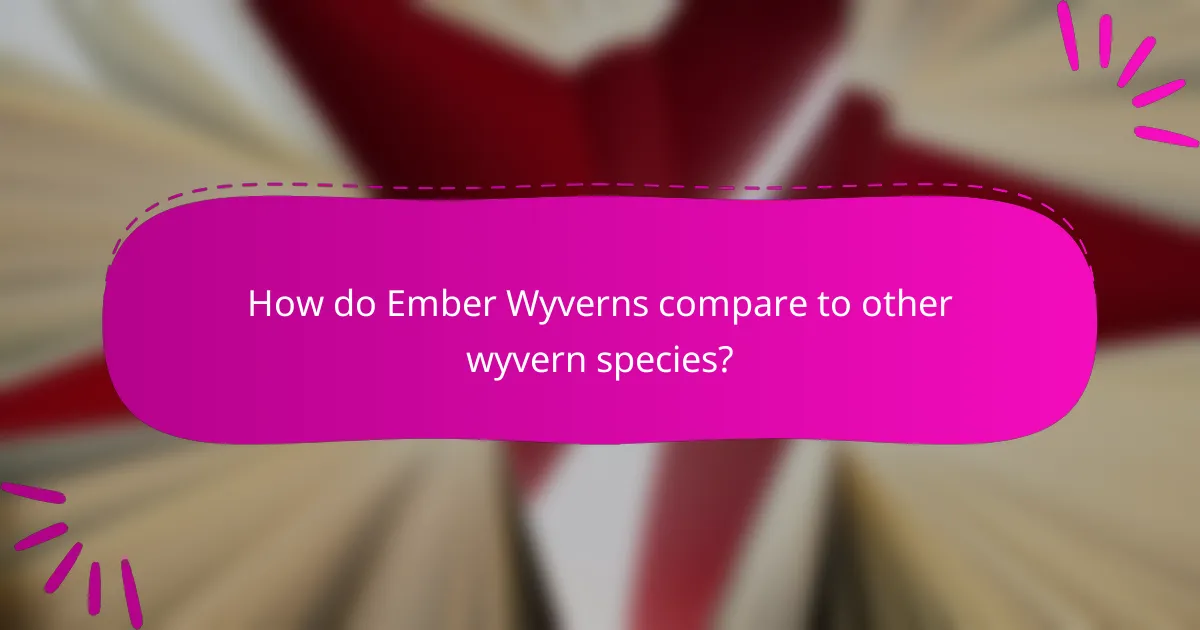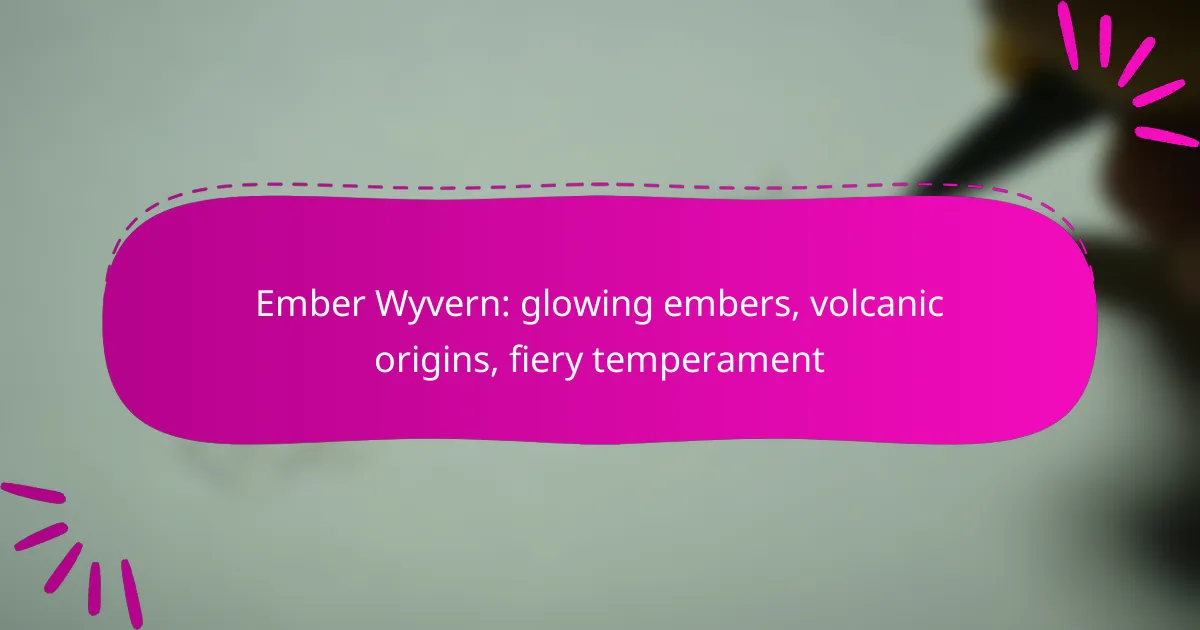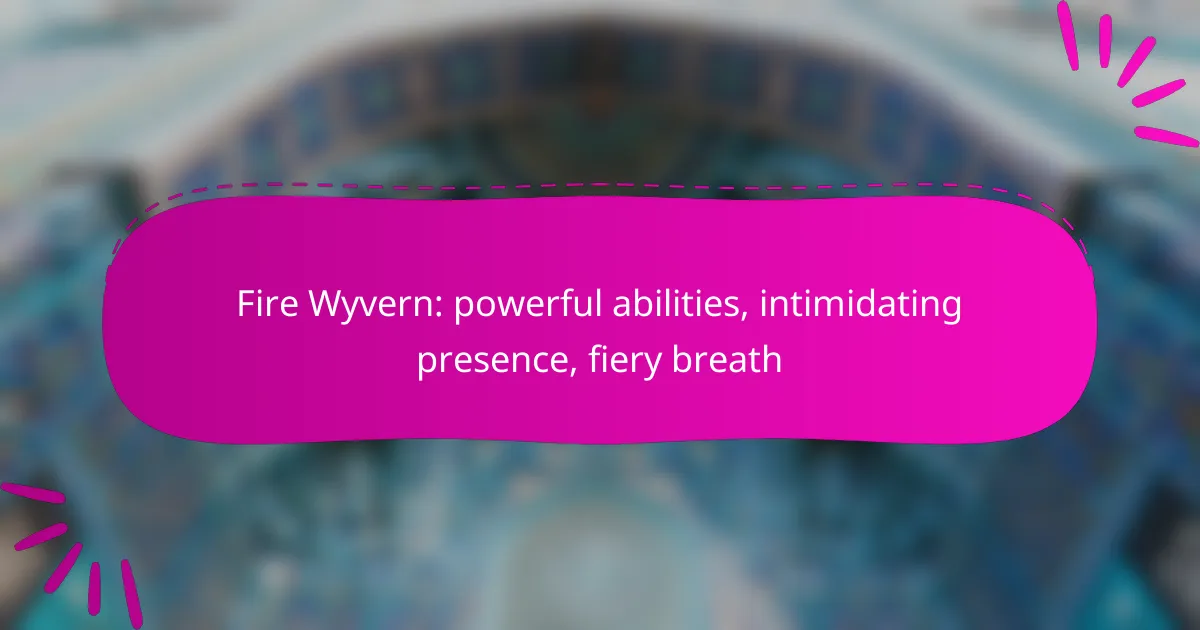Ember Wyverns are striking creatures known for their glowing embers and volcanic origins, embodying a fiery temperament that captivates those who encounter them. Thriving in warm, moist environments reminiscent of their natural habitats, these formidable beings require careful attention to their specific needs for optimal health and well-being.

How to care for Ember Wyverns in volcanic regions?
Caring for Ember Wyverns in volcanic regions requires a focus on heat, humidity, diet, and health monitoring. These creatures thrive in warm, moist environments that mimic their natural habitat, so understanding their specific needs is crucial for their well-being.
Provide adequate heat sources
Ember Wyverns need consistent heat to maintain their energy levels and overall health. In volcanic regions, natural geothermal heat can be beneficial, but additional heat sources like heat lamps or heated rocks should be used to ensure a stable temperature range of around 30-35°C (86-95°F).
Position heat sources strategically within their habitat to create warm spots, allowing the wyverns to regulate their body temperature effectively. Avoid overheating by monitoring temperatures regularly, as excessive heat can lead to dehydration and stress.
Maintain humidity levels
Humidity is essential for Ember Wyverns, as it helps them maintain hydration and skin health. Aim for humidity levels between 60-80% to mimic their natural volcanic environment. This can be achieved through regular misting or using humidifiers in their enclosure.
Monitor humidity with a hygrometer and adjust as necessary. Too low humidity can lead to respiratory issues, while too high can promote mold growth, which is harmful to their health.
Ensure proper diet
An Ember Wyvern’s diet should consist of high-quality protein sources, such as insects, small mammals, and occasionally fruits. Providing a balanced diet helps maintain their fiery temperament and energy levels. Aim for a feeding schedule of 2-3 times a week, adjusting portions based on their size and activity level.
Consider supplementing their diet with vitamins and minerals to ensure they receive all necessary nutrients. Avoid overfeeding, as obesity can lead to health complications.
Monitor health regularly
Regular health checks are vital for Ember Wyverns to catch any potential issues early. Look for signs of illness, such as changes in appetite, lethargy, or abnormal behavior. Establish a routine for health assessments every few weeks.
Keep a log of their weight, feeding habits, and any changes in their environment. This information can be invaluable for identifying trends and addressing health concerns promptly.

What are the key characteristics of Ember Wyverns?
Ember Wyverns are notable for their glowing embers, volcanic origins, and fiery temperament. These creatures exhibit unique traits that make them formidable and fascinating in their natural habitats.
Glowing embers as a defense mechanism
The glowing embers of Ember Wyverns serve as a powerful defense mechanism against predators. When threatened, these wyverns can intensify the glow of their embers, creating a dazzling display that can temporarily blind or disorient attackers.
Additionally, the embers can generate intense heat, deterring close encounters. This ability not only protects them but also signals their presence to potential mates, showcasing their health and vigor.
Volcanic habitat preferences
Ember Wyverns thrive in volcanic regions where they can find ample sources of heat and minerals. Their preferred habitats include lava fields and rocky cliffs, which provide both shelter and a steady supply of food.
These environments allow them to harness geothermal energy, aiding in their survival and reproduction. The extreme temperatures of their habitats also contribute to their unique physiology, enabling them to withstand high levels of heat.
Fiery temperament traits
The fiery temperament of Ember Wyverns is characterized by aggression and territoriality. They are known to fiercely defend their nests and hunting grounds, often engaging in displays of strength to ward off intruders.
While their temperament can make them dangerous, it also plays a crucial role in their mating rituals. Males often exhibit flamboyant behaviors, such as aerial displays and ember flares, to attract females and assert dominance over rivals.

What are the best habitats for Ember Wyverns?
Ember Wyverns thrive in environments that mimic their volcanic origins and fiery temperament. The best habitats for these creatures are characterized by active volcanic activity, mountainous terrains, and regions with abundant lava flows.
Active volcanic areas
Active volcanic areas provide the ideal conditions for Ember Wyverns, as they are naturally drawn to heat and molten rock. These regions often have high temperatures and rich mineral deposits, which support the wyverns’ unique biology. When selecting a location, look for volcanoes that have recent eruptions or ongoing geothermal activity.
Common examples of such areas include the Pacific Ring of Fire, where numerous active volcanoes can be found. These locations not only offer the necessary heat but also a variety of prey that thrive in such extreme environments.
Mountainous terrains
Mountainous terrains are another suitable habitat for Ember Wyverns, providing both elevation and access to thermal updrafts. The steep cliffs and rocky outcrops allow these creatures to nest and launch into the sky with ease. When exploring mountainous regions, focus on areas with volcanic peaks, as they often have the right combination of altitude and warmth.
Regions like the Andes or the Himalayas can be ideal, especially where volcanic activity has shaped the landscape. The cooler air at higher altitudes also helps regulate their body temperature during flight.
Regions with abundant lava flows
Regions with abundant lava flows create a rich ecosystem that supports Ember Wyverns. The heat from the lava not only provides warmth but also creates unique habitats for various prey species. When assessing these areas, look for recent lava fields that have cooled, as they can offer both shelter and hunting grounds.
Areas such as Hawaii or Iceland are perfect examples, where the combination of lava flows and diverse flora and fauna creates a thriving environment for these wyverns. Ensure that the lava flows are not too old, as they need to maintain a certain level of geothermal activity to support the Ember Wyverns effectively.

How do Ember Wyverns compare to other wyvern species?
Ember Wyverns are distinct from other wyvern species due to their fiery temperament, volcanic origins, and unique adaptations to their environment. Unlike many wyverns, they thrive in extreme heat and possess abilities that reflect their connection to fire and magma.
Differences in temperament
Ember Wyverns are known for their aggressive and fiery temperament, often displaying a more volatile nature compared to other wyvern species. They are quick to defend their territory and can be unpredictable, making encounters with them particularly dangerous.
In contrast, other wyverns, such as the more docile Forest Wyvern, may exhibit calmer behaviors and are less likely to attack unless provoked. This difference in temperament can significantly influence how trainers and adventurers approach interactions with these creatures.
Unique dietary needs
Ember Wyverns require a diet rich in minerals and nutrients found in volcanic environments. Their primary food sources include magma-infused rocks and rare flora that thrive in extreme heat. This diet not only sustains them but also enhances their fiery abilities.
In comparison, other wyvern species may have more varied diets, including herbivorous or omnivorous options. For instance, the Mountain Wyvern often feeds on mountain goats and other wildlife, reflecting its adaptation to cooler climates.
Habitat preferences
Ember Wyverns prefer habitats near active volcanoes or geothermal areas where they can bask in heat and access their unique food sources. These environments are crucial for their survival and well-being, as they thrive in high temperatures.
Other wyvern species, however, may inhabit a range of environments. For example, the Ocean Wyvern is typically found near coastal regions, while the Desert Wyvern prefers arid landscapes. Understanding these habitat preferences is essential for conservation efforts and ensuring the safety of both the creatures and humans who share their environments.

What are the risks of keeping Ember Wyverns?
Keeping Ember Wyverns poses several risks, primarily due to their fiery nature and volcanic origins. Owners must be prepared for potential fire hazards, health complications, and environmental impacts associated with these creatures.
Fire hazards
Ember Wyverns are known for their ability to breathe fire, which can lead to significant fire hazards in their surroundings. Owners should ensure that their habitats are constructed from fire-resistant materials and are located away from flammable structures.
Regular maintenance is crucial to prevent accidental fires. This includes checking for any flammable debris in the vicinity and ensuring that the wyvern’s fire-breathing capabilities are managed effectively, possibly through training and controlled environments.
Health complications
Health complications can arise from keeping Ember Wyverns, both for the creatures themselves and their owners. The intense heat generated by these wyverns can lead to respiratory issues for humans, especially in enclosed spaces.
Additionally, the wyverns may suffer from health problems if not properly cared for, such as dehydration or heat stress. Owners should monitor their wyvern’s health closely and provide ample hydration and cooling options to mitigate these risks.
Environmental impact
The environmental impact of keeping Ember Wyverns can be significant, particularly in terms of habitat destruction and local ecosystems. Their volcanic origins mean they thrive in specific environments, and introducing them to non-native areas can disrupt local wildlife.
It is essential for owners to consider the ecological footprint of their wyverns. This includes ensuring that their habitat does not encroach on protected areas and that they are not released into the wild, where they could become invasive species.

What are the best food options for Ember Wyverns?
The best food options for Ember Wyverns include high-protein meats and specialized volcanic minerals. These food types support their unique physiology and fiery temperament, ensuring they maintain their strength and vitality.
High-protein meats
Ember Wyverns thrive on high-protein meats, which are essential for their growth and energy levels. Options such as raw prime meat or cooked meat are ideal, as they provide the necessary nutrients to sustain their fiery nature.
When feeding Ember Wyverns, consider offering a variety of meats to keep their diet balanced. Regularly check for freshness and avoid spoiled options, as these can negatively impact their health.
Specialized volcanic minerals
In addition to meats, Ember Wyverns benefit from specialized volcanic minerals that enhance their fiery abilities. These minerals can often be found in volcanic regions and are crucial for their metabolic processes.
Look for minerals rich in sulfur and other volcanic elements, as they help maintain the wyvern’s glowing embers. Incorporating these minerals into their diet can improve their overall performance and resilience in harsh environments.










